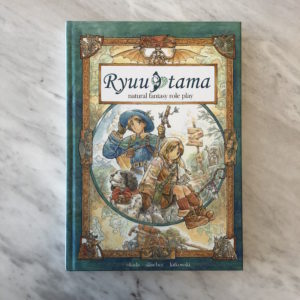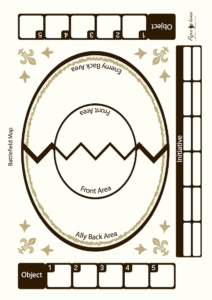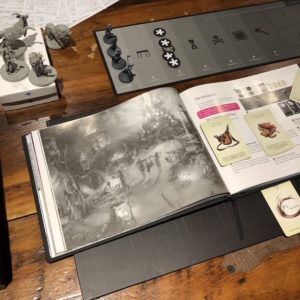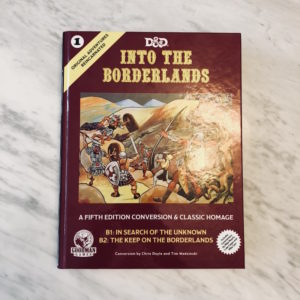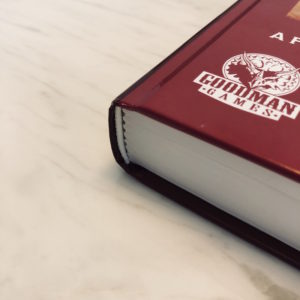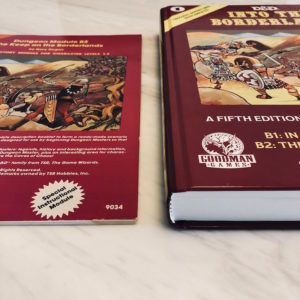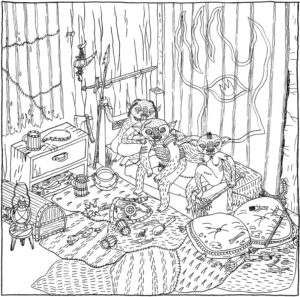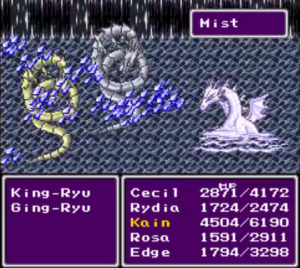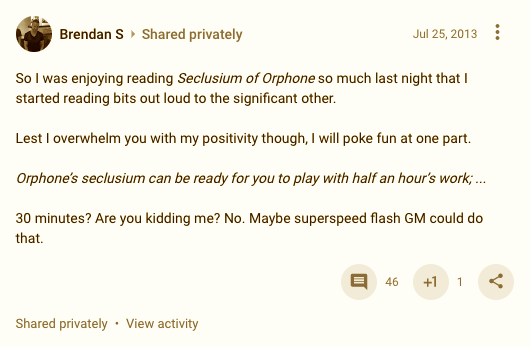
Image from Wikimedia commons
Magic systems can treat spells more like things one knows or more like things one has. That is, skills versus possessions. This is not a pure dichotomy, and various systems draw from both approaches. There is, however, a fundamental trade-off in moving along this continuum from magic as skill to magic as possession. A skills approach leads to more focused, mechanically simple, and niche-protected characters within a party. A possessions approach leads to more flexible, mechanically complex, and interchangeable characters within a party.
Skill versus possession makes the biggest difference in systems that strictly regulate skill development through acquisition of levels. Traditional D&D and similar games generally work this way. I think a more fine-grained system, such as Burning Wheel skills that develop based directly on fictional actions, would also exhibit this dynamic, but it probably would make less of a difference. In the options below, I assume skills and possessions function close to traditional D&D.
I am thinking about magic systems right now, so this is more a descriptive post to help me organize my thoughts than a proposal for a particular approach. I am curious about pushing the magic system closer to the possessions end of the spectrum while still maintaining distinctiveness between magic-using characters within a party.
Option 1: Pure Skill
In this approach, knowledge of a particular spell is like a learned skill. Characters learn new spells only by engaging character improvement mechanics directly (such as level-up) rather than through fictional actions (such as picking up a wand). Sharing spells between player characters is either impossible or costly. (See also this older post on strict spell learning.)
Perhaps surprisingly, playing B/X by the book treats spells mostly like skills for magic-users (see page B16 and this post by Alex). Magic users gain new spells on level up and there are no other rules for learning spells apart from the expensive spell research rules in the Expert rules, which require 1000 gp per spell level and seem to be intended for newly invented spells, not other spells in the existing catalog (see page X51). Apart from the research rules, spell memorization in B/X is fictional logic wrapped around a resource management fire and forget game mechanic.
Pros: simplicity, high character distinctiveness within party
Cons: can feel more like super powers, collecting spells through adventuring less emphasized
Option 2: Spell Learning
One method that takes a step toward spells as possessions is having a set of spell book rules that include systems for learning spells outside of character improvement mechanics. A magic-user can only memorize spells from a personally written spell book. This spell book or books can contain any number of spells, but copying a spell into the book requires a special action and perhaps some cost, to prevent the easy replication of spells within a party, which would give all magic-users access to the same spell list. Then, magic-users choose which spells to prepare from the book, up to level-based limits, during downtime.
AD&D popularized this approach. The AD&D rule for attempting to learn a spell is to make a percentile chance to know spell check, which is based on intelligence (AD&D Players Handbook, page 10). Characters that fail this check may never learn the spell in question. This naturally leads to spell lists unique to each magic-user. In my experience, players hate rolling to learn spells with the possibility of never being able to learn a particular spell, so though this system has some nice emergent properties, it can be a difficult sell.
Some more recent systems, such as ACKS repertoires and 5E spell slots, seem like variations on this approach, but constrain which known spells are available for actual use in play. Such constraints provide a small brake on the tendency for magic-using characters to accumulate spells without limit. Though these systems often seem superficially logical (at least to me), they also are rather complex to explain and can require extensive bookkeeping. For example, the 5E approach to spell books requires players to manage separately the spells in the book from the spells available to cast (5E Basic Rules, page 30) and spell slot implementation is, on reflection, nine different kinds of mana/spell points for for players to manage.
Pros: spell book atmosphere, moderate character distinctiveness within party, magic-users adventure to collect more spells
Cons: bookkeeping, higher chance of copying spells between player characters, often less player influence over the kind of spells learned
Option 3: Possession Plus Access Skill
Magic could also be entirely located within a possession but require a skill (or something like a skill) to use the possession. That is, a character would need something like a necromancy skill to use necromancy type magic items but such as skill would grant access to all such magic. (One could make the taxonomy of magic as fine-grained as desired to increase the likely distinctiveness of magic-using characters.) Though only intended to supplement the primary method of casting spells for characters, the traditional rule of only allowing characters belonging to the magic-user class to use stereotypically wizardly items is a crude version of this kind of approach.
A simple version of this that might work well is to take specialist rules and turn them on their head. Rather than assume generalist magic-users have access to all spells, with specialists giving up access to several schools of magic in exchange for increased power with a focal school, instead assume that generalist magic-users have no access to any spells other than those of known schools. In this way, proficiency with a school of magic would become similar to proficiency with a class of weapons, as implemented in 5E D&D.
Pros: concrete magical atmosphere
Cons: requires a skill system for acquiring access to spell schools, somewhat nonstandard, spells within school easily shared between characters
Option 4: Pure Possession
On the far end of the spectrum, the ability to cast a spell could entirely depend on character possessions. The way to get access to the fireball spell is to find a wand of fireballs (or whatever). There are various ways to place some restrictions on exchangeability, such as 5E attunement or traditional class features, but such rules often feel artificial, obviously twisting setting elements to solve a game problem.
Into the Odd uses this approach. There are not really any spells in the traditional sense and instead magic powers reside in arcana, which any character can use. I believe some arcana require something like a will save and many are consumable.
Perhaps surprisingly, given how this can sometimes lead to magic feeling like technology in a game context, it is actually closer to how magic often works in mythology and fantasy fiction. For example, Robert Howard’s sorcerer Thoth-Amon derived most or all of his magic from the serpent ring of Set. Arguably, magic in Vance’s dying earth stories sort of works like this, as non-magician characters sometimes memorize spells, though it is possible that such characters still have some sort of special talent or skill. For game purposes, this would be close to a pure gear approach.
Pros: simplicity, flexibility
Cons: characters feel less like archetypal wizards, low character distinctiveness within party
There are probably many other variations, but I think these examples illustrate some common approaches and the trade-offs that come with choosing a particular place on the rules continuum.
It is worth noting that these dynamics exist across classic classes as well, with thieves being more skill based and fighters being more possession based. For example, only thieves know how to use lock picks while fighters can usually trade weapons, though various approaches to proficiencies and so forth can change how this works. However, distinctiveness feels more important to me for magic-using character types than for mundane character types. I suspect this is true for others as well. (Explaining this feeling is perhaps a topic for another post, hopefully written by someone other than me.)
Maybe relevant: grimoires for OD&D

